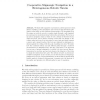Free Online Productivity Tools
i2Speak
i2Symbol
i2OCR
iTex2Img
iWeb2Print
iWeb2Shot
i2Type
iPdf2Split
iPdf2Merge
i2Bopomofo
i2Arabic
i2Style
i2Image
i2PDF
iLatex2Rtf
Sci2ools
122
click to vote
SAB
2010
Springer
2010
Springer
Cooperative Stigmergic Navigation in a Heterogeneous Robotic Swarm
We study self-organized cooperation in a heterogeneous robotic swarm consisting of two sub-swarms. The robots of each sub-swarm play distinct roles based on their different characteristics. We investigate how the swarm as a whole can solve complex tasks through a self-organized process based on local interactions between the sub-swarms. We focus on an indoor navigation task, in which we use a swarm of wheeled robots, called foot-bots, and a swarm of flying robots that can attach to the ceiling, called eye-bots. Foot-bots have to move back and forth between a source and a target location. Eye-bots are deployed in stationary positions against the ceiling, with the goal of guiding foot-bots. We study how the combined system can find efficient paths through a cluttered environment in a distributed way. The key component of our approach is a process of mutual adaptation, in which foot-bots execute instructions given by eye-bots, and eye-bots observe the behavior of foot-bots to adapt the...
Related Content
| Added | 30 Jan 2011 |
| Updated | 30 Jan 2011 |
| Type | Journal |
| Year | 2010 |
| Where | SAB |
| Authors | Frederick Ducatelle, Gianni A. Di Caro, Luca Maria Gambardella |
Comments (0)

